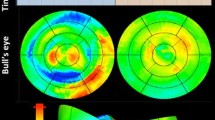Abstract
The reliability of non-invasive determination of cardiac output using first-pass radionuclide cardiography at rest and during exercise in the upright position was evaluated in 20 patients with coronary artery disease. Cardiac output values ranged from 2.97 to 5.99 1/min at rest and from 5.08 to 10.821/min during exercise. Cardiac output results obtained by the radionuclide method were compared with those derived from the thermodilution technique performed simultaneously. The mean difference between the two techniques was 0.02 1/min at rest and −0.341/min during exercise; the limits of agreement (mean±1.96 SD) were −1.29 to 1.33 1/min and −1.97 to 1.29 1/min, respectively, indicating an acceptable level of agreement. A high reproducibility of the radionuclide technique was found, with a mean difference between determinations by two observers of 0.03 1/min at rest and 0.21 1/min during exercise, the corresponding limits of agreement being −0.75 to 0.811/min and −0.79 to 1.21 1/min, respectively. With the aid of a variance component analysis of two determinations by each of four observers, 95% confidence intervals of ±10% at rest and ±12% during exercise were computed for the radionuclide cardiac output measurements. The observer variation was most pronounced for the part of the cardiac output determination related to measurement of left ventricular equilibrium activity during exercise. First-pass radionuclide cardiography is a reliable method for determination of cardiac output in cardiac patients at rest and during exercise in the upright position.
Similar content being viewed by others
References
Alazraki NP, Schelbert HR, Verba JW, Brock GW, Johnson AD, Ashburn WL (1975) Utilization of radionuclide cardiac angiogram for determination of cardiac output and ejection fraction. J Nucl Biol Med 19:127–134
Bland JM, Altman DG (1986) Statistical methods for assessing agreement between two methods of clinical measurement. Lancet I:307–310
Conway J (1990) Clinical assessment of cardiac output. Eur Heart J 11 [Suppl I]:148–150
Donato L (1973) Basic concepts of radiocardiography. Semin Nucl Med 3:111–130
Fouad FM, Tarazi RC, MacIntyre WJ, Durant D (1979) Venous delay, a major source of error in isotopic cardiac output determination. Am Heart J 97:477–484
Ganz W, Donoso R, Marcus HS, Forrester JS, Swan HJC (1971) A new technique for measurement of cardiac output by thermodilution in man. Am J Cardiol 17:392–396
Gjørup T, Kelbæk H, Vestergaard B, Fogh J, Munck O, Jensen AM (1989) Reproducibility in the analysis of multigated radionuclide studies of left ventricular ejection fraction. Invest Radiol 24:104–109
Glass J (1986) Cardiac output by radionuclide cardiography, importance of the region of interest. J Nucl Med 27:111–118
Kelbæk H, Gjørup T, Hartling OJ, Hjortsøe E (1986) The influence of a background correction that considers the heart volume on radionuclide left ventricular ejection fraction determinations. Br J Radiol 59:993–996
Kelbæk H, Hartling OJ, Skagen K, Munck O, Henriksen O, Godtfredsen J (1987) First-pass radionuclide determination of cardiac output: an improved gamma camera method. J Nucl Med 28:1330–1334
Kelbæk H, Gjørup T, Aldershvile J, Svendsen JH, Andersen B (1988) Variability in first-passage radionuclide cardiac output: hour-to-hour, day-to-day, and observer variation. Am J Noninvas Cardiol 2:213–216
Kelbæk H, Heslet L, Skagen K, Munck O, Godtfredsen J (1989a) First passage radionuclide cardiography for determination of cardiac output: evaluation of an improved method. Int J Cardiol 23:79–85
Kelbæk H, Bülow K, Aldershvile J, Møgelvang J, Nielsen SL (1989b) A new 99mTc-red blood cell labeling procedure for cardiac blood pool imaging. Clinical results. Eur J Nucl Med 15:333–335
Kuikka J (1976) In-113m radiocardiographic measurements of cardiopulmonary parameters in healthy subjects and in cardiac patients. Thesis, University of Jyväskylä, Finland
MacIntyre WJ, Pritchard WH, Moir TW (1958) The determination of cardiac output by the dilution method without arterial sampling: analytical concepts. Circulation 18:1139–1146
MacKenzie JD, Haites NA, Rawles JM (1986) Method of assessing the reproducibility of blood flow measurement: factors influencing the performance of thermodilution cardiac output computers. Br Heart J 55:14–24
Melin JA, Wijns W, Robert A et al. (1985) Validation of radionuclide cardiac output measurements during exercise. J Nucl Med 26:1386–1393
Shipley RA, Clark RE, Liebowitz D, Krohmer JS (1953) Analysis of the radiocardiogram in heart failure. Circ Res 1:428–438
Thompson HK, Starmer CF, Whalen RE, McIntosh HD (1964) Indicator transit time considered as a gamma variate. Circ Res 14:502–515
Verani MS, Gaeta J, LeBlanc AD et al. (1985) Validation of left ventricular volume measurements by radionuclide angiography. J Nucl Med 26:1139–1401
Author information
Authors and Affiliations
Rights and permissions
About this article
Cite this article
Kelbæk, H., Gjørup, T., Hvid-Jacobsen, K. et al. Reliability of first-pass radionuclide determination of cardiac output in the upright position at rest and during exercise. Eur J Nucl Med 19, 955–959 (1992). https://doi.org/10.1007/BF00175861
Received:
Revised:
Issue Date:
DOI: https://doi.org/10.1007/BF00175861




